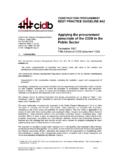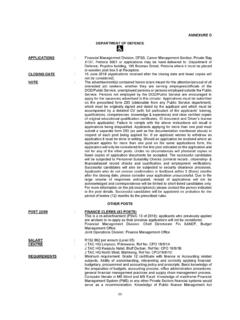Transcription of GUIDELINE ON IRREGULAR EXPENDITURE - National Treasury
1 GUIDELINE ON IRREGULAR EXPENDITURE 1 | P a g e GUIDELINE ON IRREGULAR EXPENDITURE OFFICE OF THE ACCOUNTANT-GENERAL May 2014 GUIDELINE ON IRREGULAR EXPENDITURE 2 | P a g e PURPOSE 1. The purpose of this GUIDELINE is to provide clarity on the procedures1 to be followed when dealing with the identification and application of IRREGULAR EXPENDITURE , defined in section 1 of the Public Finance Management Act (PFMA), 1999 as EXPENDITURE other than unauthorised EXPENDITURE , incurred in contravention of or that is not in accordance with a requirement of any applicable legislation, including (a) this Act; or (b) the State Tender Board Act, 1968 (Act No.)
2 86 of 1968), or any regulations made in terms of that Act; or (c) any provincial legislation providing for procurement procedures in that provincial government. 2. This Act in section 1 of the PFMA includes any regulations and instructions issued in terms of section 69, 76, 85 or 91. APPLICABILITY 3. This GUIDELINE applies to all departments, government components, trading entities, constitutional institutions and public entities listed in Schedule 2 and 3 to the PFMA. THE STATE TENDER BOARD ACT, 1968 4. The State Tender Board Act, 1968 (Act No. 86 of 1968) establishes the State Tender Board and provides, among others, for regulating the procurement of goods and services of National departments, for the disposal of movable property and the hiring or letting of anything.
3 Provinces had similar legislation that established Provincial Tender Boards and which offered matters similar to those provided for in State Tender Board Act, 1968. 5. It must be noted that in section 1 of the PFMA, IRREGULAR EXPENDITURE is also deemed to have occurred if there was contravention of the State Tender Board Act, 1968 (Act No. 86 of 1968), or any regulations made in terms of that Act. 6. In December 2003, the National Treasury issued a Supply Chain Management Framework in terms of section 76(4)(c) of the PFMA.
4 This Framework was published in Government Gazette No. 25767 dated 5 December 2003 and took effect from the same date. 1 This GUIDELINE does not prescribe any new principle or procedure related to the identification and application of IRREGULAR EXPENDITURE but is merely a consolidation of provisions that are currently contained in Practice Note 4 of 2008/2009 on IRREGULAR EXPENDITURE . GUIDELINE ON IRREGULAR EXPENDITURE 3 | P a g e 7. In essence, the aforementioned Framework provides that accounting officers and accounting authorities of Schedule 3A and 3C public entities must develop and implement effective and efficient systems of supply chain management and to establish separate supply chain management units reporting to their respective chief financial officers.
5 8. Prior to this Framework taking effect, all National and provincial departments arranged for the procurement of their goods and services in terms of legislation that established their respective Tender Boards. 9. After this Framework took effect, all Provinces repealed legislation that established their respective Provincial Tender Boards and which also determined the manner in which their supplies (goods) and services were procured. 10. When the Supply Chain Management Framework took effect, it was recognized that the State Tender Board Act, 1968 (Act No.)
6 86 of 1968) provided that National departments were only to procure their supplies for goods and services through the State Tender Board. This in effect was in conflict with provisions of the Supply Chain Management Framework, which required departments to procure their goods and services either through the State Tender Board or in terms of the PFMA. 11. On 5 December 2003, the Minister of Finance therefore published an amendment to regulations in terms of section 13 of the State Tender Board Act, 1968 (Act No. 86 of 1968) which essentially allowed for accounting officers of National departments to procure their goods and services either through the State Tender Board or by using the provisions contained in the Supply Chain Management Framework.
7 12. The amendment to the State Tender Board Act Regulations is consistent with the ethos of the PFMA which empowers accounting officers to manage but be held accountable for all EXPENDITURE incurred by their respective departments. 13. Whilst the above amendment provides for a dual system of procurement, the State Tender Board at the National level of government has since been disbanded and it is the intention to repeal the currently dormant State Tender Board Act, 1968 (Act No. 86 of 1968) when amendments are effected to the PFMA. PRINCIPLES FOR IRREGULAR EXPENDITURE 14.
8 For a department or a government component2 to incur IRREGULAR EXPENDITURE , the non-compliance must be linked to a financial transaction. Although a transaction, condition or an event may trigger IRREGULAR EXPENDITURE , a department or government component will only record IRREGULAR EXPENDITURE when a payment pertaining to the 2 This provision is applicable to those government components that are currently applying the modified cash basis of accounting and the Modified Cash Standard issued by the National Treasury .
9 GUIDELINE ON IRREGULAR EXPENDITURE 4 | P a g e non-compliance is actually made ( when the EXPENDITURE is recognized in accordance with the recognition principles contained in the Modified Cash Standard). If possible IRREGULAR EXPENDITURE is determined prior to a payment being made, then such a transgression shall be regarded as a non-compliance matter until payment is made at which point IRREGULAR EXPENDITURE shall be recorded. Non-compliance corrected prior to any payment being made will not result in any IRREGULAR EXPENDITURE . 15. A constitutional institution, trading entity or public entity listed in Schedules 2 and 3 to the PFMA shall incur IRREGULAR EXPENDITURE when a transaction, condition or an event linked to the non-compliance is recognized as EXPENDITURE in the Statement of Financial Performance in accordance with the Standards of Generally Recognised Accounting Practice (GRAP), the Standards of Generally Accepted Accounting Practice (GAAP) or the International Financial Reporting Standards (IFRS).
10 16. The principle in paragraph 15 above shall also apply to government components that are required to comply with Standards of Generally Recognised Accounting Practice (GRAP), the Standards of Generally Accepted Accounting Practice (GAAP) or the International Financial Reporting Standards (IFRS). 17. For the purposes of determining whether IRREGULAR EXPENDITURE has taken place, there must have been a transgression of a provision contained in any applicable legislation which shall include:- (a) the PFMA; (b) the Treasury Regulations; (c) a National Treasury Instruction, issued in terms of section 76 of the PFMA; and (d) a Provincial Treasury Instruction issued in terms of section 18(2)(a) of the PFMA.















